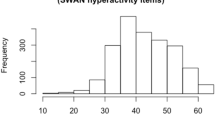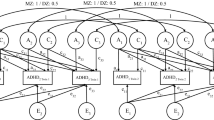Abstract
Objective
Attention deficit hyperactivity disorder (ADHD) is a common, complex and highly heritable disorder, characterised by inattentive, impulsive and overactive behaviour. Evidence for the heritability of ADHD measures in twin population samples has come from the analysis of total scores that combine inattentive and hyperactive–impulsive symptoms subscales. This study investigated, in a community sample, the aetiology of ADHD-like traits and the aetiological overlap between the two dimensions that define the ADHD disorder.
Materials and Methods
Parents of 6,222 approximately 8-year-old twin pairs from the Twins Early Development Study (TEDS) population sample completed the two subscales of the Conners’ 18-item DSMIV checklist, a screening instrument for ADHD symptoms.
Results
Both subscales were highly heritable (hyperactive–impulsive: 88%; inattentive: 79%). Bivariate genetic modelling indicated substantial genetic overlap between the two components; however, there were significant independent genetic effects.
Conclusions
These findings suggest that many genes associated with the hyperactivity–impulsivity dimension will also be associated with the inattentive dimension but that there is significant genetic heterogeneity as well. These results provide genetic support for combining the two behavioural dimensions that define ADHD, but also suggest that some symptom-specific genes will also be identified.
Similar content being viewed by others
References
Akaike, H. (1987). Factor analysis and AIC. Psychometrika, 52, 317–332.
American Psychiatric Association (APA) (1994). Diagnostic and statistical manual of mental disorders (4th ed.). Washington, DC: American Psychiatric Association.
Conners, C. K., Sitarenios, G., Parker, J. D., & Epstein, J. N. (1998). The revised Conners’ parent rating scale (CPRS-R): Factor structure, reliability, and criterion validity. Journal of Abnormal Child Psychology, 26, 257–268.
Eaves, L., Rutter, M., Silberg, J. L., Shillady, L., Maes, H., & Pickles, A. (2000). Genetic and environmental causes of covariation in interview assessments of disruptive behavior in child and adolescent twins. Behavior Genetics, 30, 321–334.
Faraone, S. V., Biederman, J., & Friedman, D. (2000). Validity of DSM-IV subtypes of attention-deficit/hyperactivity disorder: A family study perspective. Journal of the American Academy of Child and Adolescent Psychiatry, 39, 300–307.
Freeman, B., Smith, N., Curtis, C., Huckett, L., Mill, J., & Craig, I. W. (2003). DNA from buccal swabs recruited by mail: Evaluation of storage effects on longterm stability and suitability for multiplex polymerase chain reaction genotyping. Behavior Genetics, 33, 67–72.
Hudziak, J. J., Heath, A. C., Madden, P. F., Reich, W., Bucholz, K. K., Slutske, W., et al. (1998). Latent class and factor analysis of DSM-IV ADHD: A twin study of female adolescents. Journal of the American Academy of Child and Adolescent Psychiatry, 37, 848–857.
Kuntsi, J., McLoughlin, G., & Asherson, P. (2006). Attention deficit hyperactivity disorder. Neuromolecular Medicine, 8(4), 461–484.
Kuntsi, J., Rijsdijk, F., Ronald, A., Asherson, P., & Plomin, R. (2005). Genetic influences on the stability of attention-deficit/hyperactivity disorder symptoms from early to middle childhood. Biological Psychiatry, 57, 647–654.
Lahey, B. B., Applegate, B., McBurnett, K., Biederman, J., Greenhill, L., Hynd, G. W., et al. (1994). DSM-IV field trials for attention deficit hyperactivity disorder in children and adolescents. American Journal of Psychiatry, 151, 1673–1685.
Lahey, B. B., Schaughency, E. A., Hynd, G. W., Carlson, C. L., & Nieves, N. (1987). Attention deficit disorder with and without hyperactivity: Comparison of behavioral characteristics of clinic-referred children. Journal of the American Academy of Child and Adolescent Psychiatry, 26, 718–723.
Larsson, H., Lichtenstein, P., & Larsson, J. O. (2006). Genetic contributions to the development of ADHD subtypes from childhood to adolescence. Journal of the American Academy of Child and Adolescent Psychiatry, 45, 973–981.
Levy, F., McStephen, M., & Hay, D. A. (2001). The diagnostic genetics of ADHD symptoms and subtypes. In F. Levy & D. Hay (Eds.), Attention, genes and ADHD (pp. 35–37). Philadelphia: Taylor & Francis.
Lowe, N., Kirley, A., Hawi, Z., Sham, P., Wickham, H., Kratochvil, C. J., et al. (2004). Joint analysis of the DRD5 marker concludes association with attention-deficit/hyperactivity disorder confined to the predominantly inattentive and combined subtypes. American Journal of Human Genetics, 74, 348–356.
McBurnett, K., Pfiffner, L. J., & Frick, P. J. (2001). Symptom properties as a function of ADHD type: An argument for continued study of sluggish cognitive tempo. Journal of Abnormal Child Psychology, 29, 207–213.
Neale, M. C. (1997) Mx: Statistical modelling. Richmond, VA: Department of Psychiatry, Medical College of Virginia.
Neale, M. C., & Cardon, L. R. (1992) Methodology for genetic studies of twins and families. Dordrecht: Kluwer.
Neale, M. C., & Miller, M. B. (1997). The use of likelihood-based confidence intervals in genetic models. Behavior Genetics, 27(2), 113–120.
Neale, M. C., Roysamb, E., Jacobson, K. (2006). Multivariate genetic analysis of sex limitation and G × E interaction. Twin Research and Human Genetics, 9, 481–489.
Nigg, J. T., Stavro, G., Ettenhofer, M., Hambrick, D. Z., Miller, T., & Henderson, J. M. (2005). Executive functions and ADHD in adults: Evidence for selective effects on ADHD symptom domains. Journal of Abnormal Psychology, 114, 706–717.
Office for National Statistics (2002). Living in Britain: Results from the 2000/01 General Household Survey. Anonymous.
Pelham, W. E., Jr., Gnagy, E. M., Greenslade, K. E., & Milich, R. (1992). Teacher ratings of DSM-III-R symptoms for the disruptive behavior disorders. Journal of the American Academy of Child and Adolescent Psychiatry, 31, 210–218.
Plomin, R., DeFries, J. C., McClearn, G. E., & McGuffin, P. (2001). Behavioural genetics. New York: Worth.
Price, T. S., Freeman, B., Craig, I., Petrill, S. A., Ebersole, L., & Plomin, R. (2000). Infant zygosity can be assigned by parental report questionnaire data. Twin Research, 3, 129–133.
Rasmussen, E. R., Neuman, R. J., Heath, A. C., Levy, F., Hay, D. A., & Todd, R. D. (2004). Familial clustering of latent class and DSM-IV defined attention-deficit/hyperactivity disorder (ADHD) subtypes. Journal of Child Psychology and Psychiatry, 45, 589–598.
Rhee, S. H., Waldman, I. D., Hay, D. A., & Levy, F. (1999). Sex differences in genetic and environmental influences on DSM-III-R attention-deficit/hyperactivity disorder. Journal of Abnormal Psychology, 108, 24–41.
Sherman, D. K., Iacono, W. G., & McGue, M. K. (1997). Attention-deficit hyperactivity disorder dimensions: A twin study of inattention and impulsivity–hyperactivity. Journal of the American Academy of Child and Adolescent Psychiatry, 36, 745–753.
Smalley, S. L., McGough, J. J., Del’Homme, M., NewDelman, J., Gordon, E., Kim, T., et al. (2000). Familial clustering of symptoms and disruptive behaviors in multiplex families with attention-deficit/hyperactivity disorder. Journal of the American Academy of Child and Adolescent Psychiatry, 39, 1135–1143.
Smoller, J. W., Biederman, J., Arbeitman, L., Doyle, A. E., Fagerness, J., Perlis, R. H., et al. (2006). Association between the 5HT1B receptor gene (HTR1B) and the inattentive subtype of ADHD. Biological Psychiatry, 59, 460–467.
Spinath, F. M., Ronald, A., Harlaar, N., Price, T. S., & Plomin, R. (2004). Phenotypic ‘g’ early in life: On the etiology of general cognitive ability in a large population sample of twin children aged 2 to 4 years. Intelligence, 31, 195–210.
Stata Corporation. (1997). Stata statistical software (Release 9.0), College Station, TX: Stata Corp.
Stawicki, J. A., Nigg, J. T., & von Eye, A. (2006). Family psychiatric history evidence on the nosological relations of DSM-IV ADHD combined and inattentive subtypes: New data and meta-analysis. Journal of Child Psychology and Psychiatry, 47, 935–945.
Todd, R. D., Rasmussen, E. R., Neuman, R. J., Reich, W., Hudziak, J. J., Bucholz, K. K., et al. (2001). Familiality and heritability of subtypes of attention deficit hyperactivity disorder in a population sample of adolescent female twins. American Journal of Psychiatry, 158, 1891–1898.
Todd, R. D., Rasmussen, E. R., Wood, C., Levy, F., & Hay, D. A. (2004). Should sluggish cognitive tempo symptoms be included in the diagnosis of attention-deficit/hyperactivity disorder? Journal of the American Academy of Child and Adolescent Psychiatry, 43, 588–597.
Acknowledgements
We are indebted to participants of the Twins Early Development Study (TEDS) for making the study possible. The authors have no financial relationships to disclose. TEDS is funded by MRC grant G0500079. Angelica Ronald is funded by a fellowship from Autism Speaks.
Author information
Authors and Affiliations
Corresponding author
Additional information
Correspondence and reprint requests to Gráinne McLoughlin, SGDP Centre, Institute of Psychiatry, De Crespigny Park, London SE5 8AF, Tel: +44(0) 207-848-5261; Email: g.mcloughlin@iop.kcl.ac.uk.
Rights and permissions
About this article
Cite this article
McLoughlin, G., Ronald, A., Kuntsi, J. et al. Genetic Support for the Dual Nature of Attention Deficit Hyperactivity Disorder: Substantial Genetic Overlap Between the Inattentive and Hyperactive–impulsive Components. J Abnorm Child Psychol 35, 999–1008 (2007). https://doi.org/10.1007/s10802-007-9149-9
Received:
Accepted:
Published:
Issue Date:
DOI: https://doi.org/10.1007/s10802-007-9149-9




